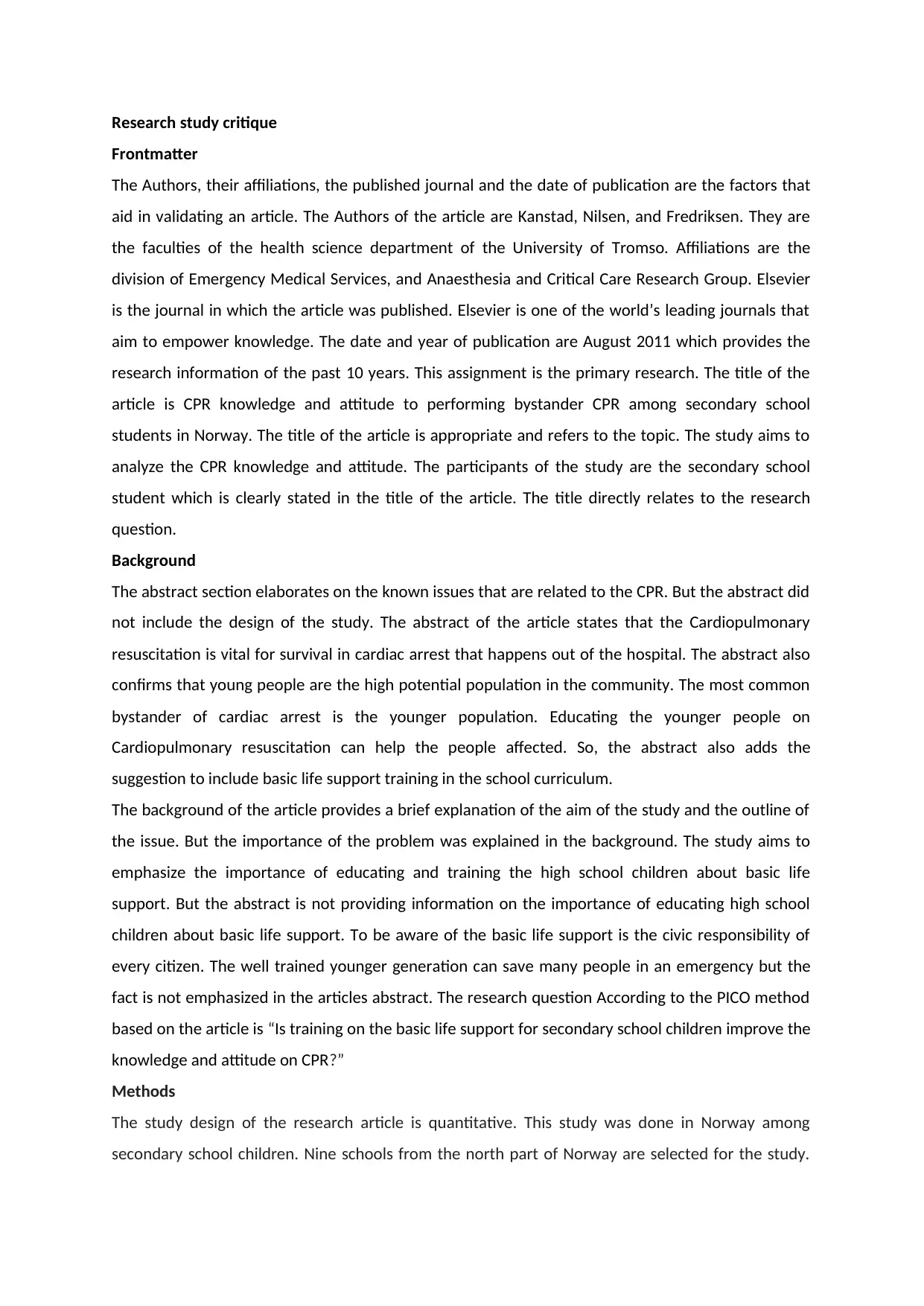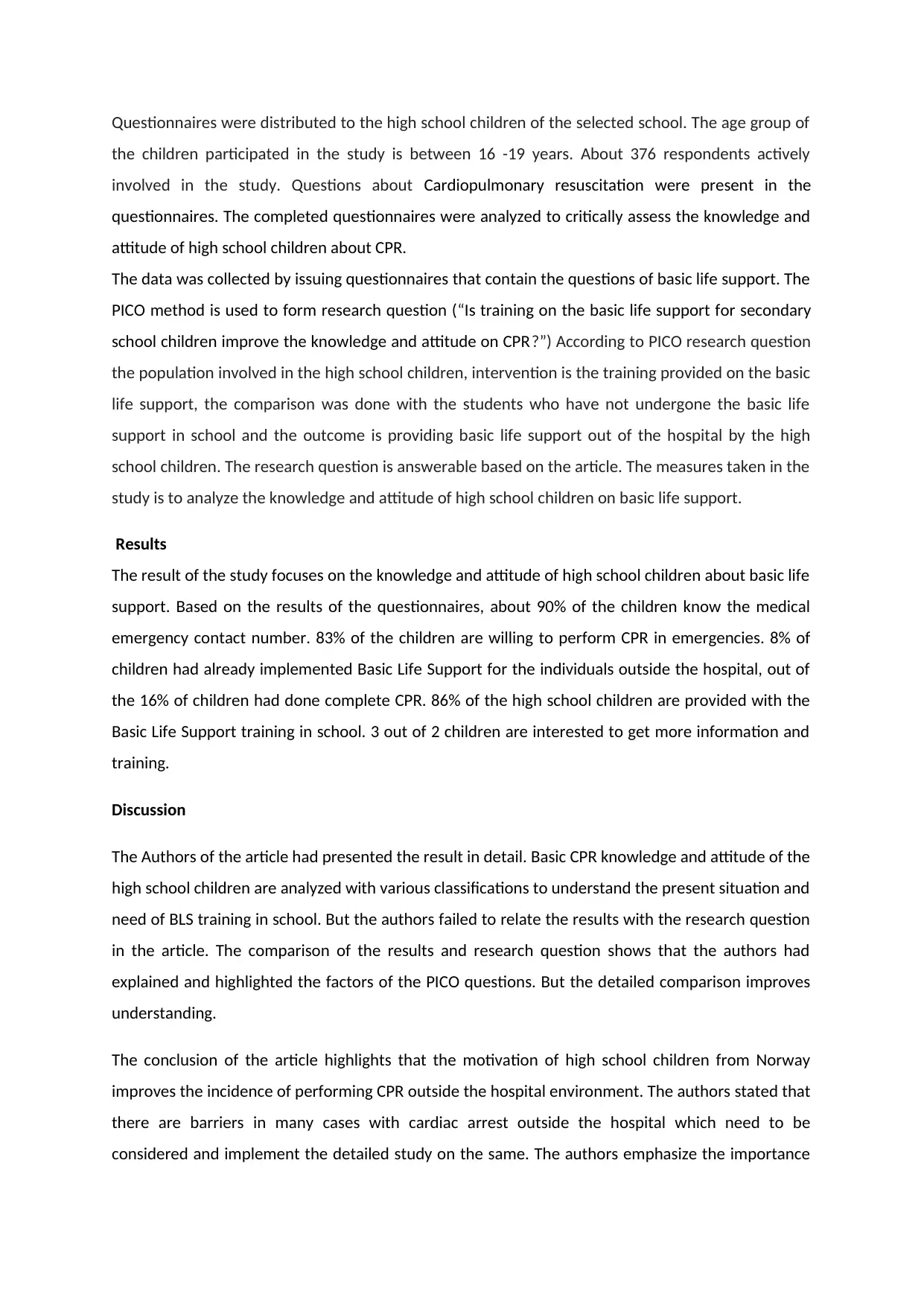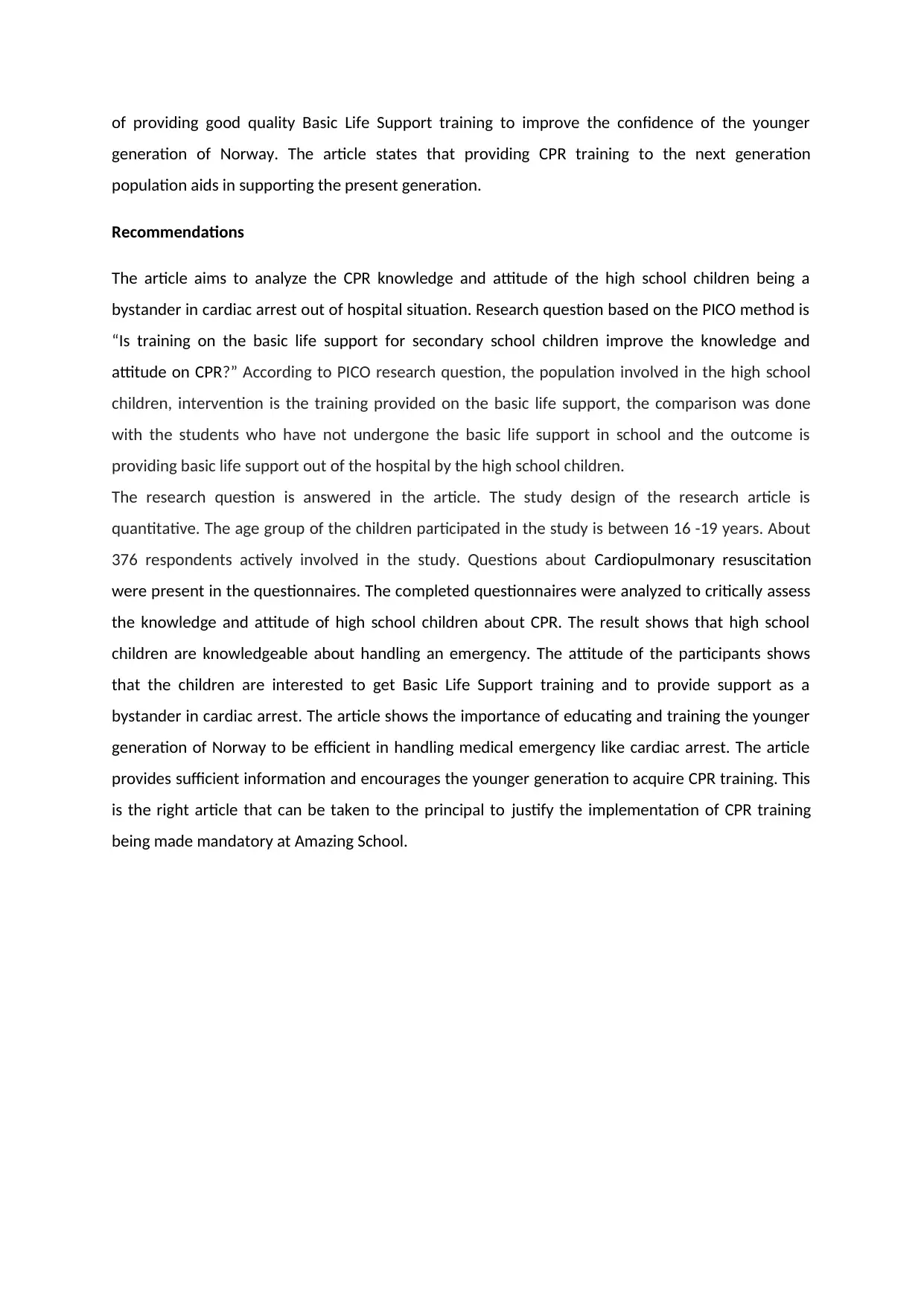University Health Research: CPR Knowledge and Attitude Critique Report
VerifiedAdded on 2022/08/24
|4
|1352
|20
Report
AI Summary
This report provides a comprehensive critique of a research article titled "CPR knowledge and attitude to performing bystander CPR among secondary school students in Norway." The study, conducted by Kanstad, Nilsen, and Fredriksen, investigated the CPR knowledge and attitudes of secondary school students in Norway using questionnaires. The critique evaluates the front matter, including the authors' affiliations and the journal's credibility. It analyzes the background, research question (framed using the PICO method), methods (quantitative study design), results (knowledge and willingness to perform CPR), discussion, and recommendations. The report highlights the study's strengths, such as the clear methodology and relevant findings regarding the importance of CPR training for the younger generation, while also pointing out areas for improvement, such as relating the results directly to the research question. The critique concludes with a positive assessment of the article's value in advocating for mandatory CPR training in schools.

Research study critique
Frontmatter
The Authors, their affiliations, the published journal and the date of publication are the factors that
aid in validating an article. The Authors of the article are Kanstad, Nilsen, and Fredriksen. They are
the faculties of the health science department of the University of Tromso. Affiliations are the
division of Emergency Medical Services, and Anaesthesia and Critical Care Research Group. Elsevier
is the journal in which the article was published. Elsevier is one of the world’s leading journals that
aim to empower knowledge. The date and year of publication are August 2011 which provides the
research information of the past 10 years. This assignment is the primary research. The title of the
article is CPR knowledge and attitude to performing bystander CPR among secondary school
students in Norway. The title of the article is appropriate and refers to the topic. The study aims to
analyze the CPR knowledge and attitude. The participants of the study are the secondary school
student which is clearly stated in the title of the article. The title directly relates to the research
question.
Background
The abstract section elaborates on the known issues that are related to the CPR. But the abstract did
not include the design of the study. The abstract of the article states that the Cardiopulmonary
resuscitation is vital for survival in cardiac arrest that happens out of the hospital. The abstract also
confirms that young people are the high potential population in the community. The most common
bystander of cardiac arrest is the younger population. Educating the younger people on
Cardiopulmonary resuscitation can help the people affected. So, the abstract also adds the
suggestion to include basic life support training in the school curriculum.
The background of the article provides a brief explanation of the aim of the study and the outline of
the issue. But the importance of the problem was explained in the background. The study aims to
emphasize the importance of educating and training the high school children about basic life
support. But the abstract is not providing information on the importance of educating high school
children about basic life support. To be aware of the basic life support is the civic responsibility of
every citizen. The well trained younger generation can save many people in an emergency but the
fact is not emphasized in the articles abstract. The research question According to the PICO method
based on the article is “Is training on the basic life support for secondary school children improve the
knowledge and attitude on CPR?”
Methods
The study design of the research article is quantitative. This study was done in Norway among
secondary school children. Nine schools from the north part of Norway are selected for the study.
Frontmatter
The Authors, their affiliations, the published journal and the date of publication are the factors that
aid in validating an article. The Authors of the article are Kanstad, Nilsen, and Fredriksen. They are
the faculties of the health science department of the University of Tromso. Affiliations are the
division of Emergency Medical Services, and Anaesthesia and Critical Care Research Group. Elsevier
is the journal in which the article was published. Elsevier is one of the world’s leading journals that
aim to empower knowledge. The date and year of publication are August 2011 which provides the
research information of the past 10 years. This assignment is the primary research. The title of the
article is CPR knowledge and attitude to performing bystander CPR among secondary school
students in Norway. The title of the article is appropriate and refers to the topic. The study aims to
analyze the CPR knowledge and attitude. The participants of the study are the secondary school
student which is clearly stated in the title of the article. The title directly relates to the research
question.
Background
The abstract section elaborates on the known issues that are related to the CPR. But the abstract did
not include the design of the study. The abstract of the article states that the Cardiopulmonary
resuscitation is vital for survival in cardiac arrest that happens out of the hospital. The abstract also
confirms that young people are the high potential population in the community. The most common
bystander of cardiac arrest is the younger population. Educating the younger people on
Cardiopulmonary resuscitation can help the people affected. So, the abstract also adds the
suggestion to include basic life support training in the school curriculum.
The background of the article provides a brief explanation of the aim of the study and the outline of
the issue. But the importance of the problem was explained in the background. The study aims to
emphasize the importance of educating and training the high school children about basic life
support. But the abstract is not providing information on the importance of educating high school
children about basic life support. To be aware of the basic life support is the civic responsibility of
every citizen. The well trained younger generation can save many people in an emergency but the
fact is not emphasized in the articles abstract. The research question According to the PICO method
based on the article is “Is training on the basic life support for secondary school children improve the
knowledge and attitude on CPR?”
Methods
The study design of the research article is quantitative. This study was done in Norway among
secondary school children. Nine schools from the north part of Norway are selected for the study.
Paraphrase This Document
Need a fresh take? Get an instant paraphrase of this document with our AI Paraphraser

Questionnaires were distributed to the high school children of the selected school. The age group of
the children participated in the study is between 16 -19 years. About 376 respondents actively
involved in the study. Questions about Cardiopulmonary resuscitation were present in the
questionnaires. The completed questionnaires were analyzed to critically assess the knowledge and
attitude of high school children about CPR.
The data was collected by issuing questionnaires that contain the questions of basic life support. The
PICO method is used to form research question (“Is training on the basic life support for secondary
school children improve the knowledge and attitude on CPR?”) According to PICO research question
the population involved in the high school children, intervention is the training provided on the basic
life support, the comparison was done with the students who have not undergone the basic life
support in school and the outcome is providing basic life support out of the hospital by the high
school children. The research question is answerable based on the article. The measures taken in the
study is to analyze the knowledge and attitude of high school children on basic life support.
Results
The result of the study focuses on the knowledge and attitude of high school children about basic life
support. Based on the results of the questionnaires, about 90% of the children know the medical
emergency contact number. 83% of the children are willing to perform CPR in emergencies. 8% of
children had already implemented Basic Life Support for the individuals outside the hospital, out of
the 16% of children had done complete CPR. 86% of the high school children are provided with the
Basic Life Support training in school. 3 out of 2 children are interested to get more information and
training.
Discussion
The Authors of the article had presented the result in detail. Basic CPR knowledge and attitude of the
high school children are analyzed with various classifications to understand the present situation and
need of BLS training in school. But the authors failed to relate the results with the research question
in the article. The comparison of the results and research question shows that the authors had
explained and highlighted the factors of the PICO questions. But the detailed comparison improves
understanding.
The conclusion of the article highlights that the motivation of high school children from Norway
improves the incidence of performing CPR outside the hospital environment. The authors stated that
there are barriers in many cases with cardiac arrest outside the hospital which need to be
considered and implement the detailed study on the same. The authors emphasize the importance
the children participated in the study is between 16 -19 years. About 376 respondents actively
involved in the study. Questions about Cardiopulmonary resuscitation were present in the
questionnaires. The completed questionnaires were analyzed to critically assess the knowledge and
attitude of high school children about CPR.
The data was collected by issuing questionnaires that contain the questions of basic life support. The
PICO method is used to form research question (“Is training on the basic life support for secondary
school children improve the knowledge and attitude on CPR?”) According to PICO research question
the population involved in the high school children, intervention is the training provided on the basic
life support, the comparison was done with the students who have not undergone the basic life
support in school and the outcome is providing basic life support out of the hospital by the high
school children. The research question is answerable based on the article. The measures taken in the
study is to analyze the knowledge and attitude of high school children on basic life support.
Results
The result of the study focuses on the knowledge and attitude of high school children about basic life
support. Based on the results of the questionnaires, about 90% of the children know the medical
emergency contact number. 83% of the children are willing to perform CPR in emergencies. 8% of
children had already implemented Basic Life Support for the individuals outside the hospital, out of
the 16% of children had done complete CPR. 86% of the high school children are provided with the
Basic Life Support training in school. 3 out of 2 children are interested to get more information and
training.
Discussion
The Authors of the article had presented the result in detail. Basic CPR knowledge and attitude of the
high school children are analyzed with various classifications to understand the present situation and
need of BLS training in school. But the authors failed to relate the results with the research question
in the article. The comparison of the results and research question shows that the authors had
explained and highlighted the factors of the PICO questions. But the detailed comparison improves
understanding.
The conclusion of the article highlights that the motivation of high school children from Norway
improves the incidence of performing CPR outside the hospital environment. The authors stated that
there are barriers in many cases with cardiac arrest outside the hospital which need to be
considered and implement the detailed study on the same. The authors emphasize the importance

of providing good quality Basic Life Support training to improve the confidence of the younger
generation of Norway. The article states that providing CPR training to the next generation
population aids in supporting the present generation.
Recommendations
The article aims to analyze the CPR knowledge and attitude of the high school children being a
bystander in cardiac arrest out of hospital situation. Research question based on the PICO method is
“Is training on the basic life support for secondary school children improve the knowledge and
attitude on CPR?” According to PICO research question, the population involved in the high school
children, intervention is the training provided on the basic life support, the comparison was done
with the students who have not undergone the basic life support in school and the outcome is
providing basic life support out of the hospital by the high school children.
The research question is answered in the article. The study design of the research article is
quantitative. The age group of the children participated in the study is between 16 -19 years. About
376 respondents actively involved in the study. Questions about Cardiopulmonary resuscitation
were present in the questionnaires. The completed questionnaires were analyzed to critically assess
the knowledge and attitude of high school children about CPR. The result shows that high school
children are knowledgeable about handling an emergency. The attitude of the participants shows
that the children are interested to get Basic Life Support training and to provide support as a
bystander in cardiac arrest. The article shows the importance of educating and training the younger
generation of Norway to be efficient in handling medical emergency like cardiac arrest. The article
provides sufficient information and encourages the younger generation to acquire CPR training. This
is the right article that can be taken to the principal to justify the implementation of CPR training
being made mandatory at Amazing School.
generation of Norway. The article states that providing CPR training to the next generation
population aids in supporting the present generation.
Recommendations
The article aims to analyze the CPR knowledge and attitude of the high school children being a
bystander in cardiac arrest out of hospital situation. Research question based on the PICO method is
“Is training on the basic life support for secondary school children improve the knowledge and
attitude on CPR?” According to PICO research question, the population involved in the high school
children, intervention is the training provided on the basic life support, the comparison was done
with the students who have not undergone the basic life support in school and the outcome is
providing basic life support out of the hospital by the high school children.
The research question is answered in the article. The study design of the research article is
quantitative. The age group of the children participated in the study is between 16 -19 years. About
376 respondents actively involved in the study. Questions about Cardiopulmonary resuscitation
were present in the questionnaires. The completed questionnaires were analyzed to critically assess
the knowledge and attitude of high school children about CPR. The result shows that high school
children are knowledgeable about handling an emergency. The attitude of the participants shows
that the children are interested to get Basic Life Support training and to provide support as a
bystander in cardiac arrest. The article shows the importance of educating and training the younger
generation of Norway to be efficient in handling medical emergency like cardiac arrest. The article
provides sufficient information and encourages the younger generation to acquire CPR training. This
is the right article that can be taken to the principal to justify the implementation of CPR training
being made mandatory at Amazing School.
⊘ This is a preview!⊘
Do you want full access?
Subscribe today to unlock all pages.

Trusted by 1+ million students worldwide

Reference
Kanstad, B. K., Nilsen, S. A., & Fredriksen, K. C. P. R. (2011). CPR knowledge and attitude to
performing bystander CPR among secondary school students in
Norway. Resuscitation, 82(8), 1053-1059
https://www.sciencedirect.com/science/article/abs/pii/S0300957211002280
Kanstad, B. K., Nilsen, S. A., & Fredriksen, K. C. P. R. (2011). CPR knowledge and attitude to
performing bystander CPR among secondary school students in
Norway. Resuscitation, 82(8), 1053-1059
https://www.sciencedirect.com/science/article/abs/pii/S0300957211002280
1 out of 4
Your All-in-One AI-Powered Toolkit for Academic Success.
+13062052269
info@desklib.com
Available 24*7 on WhatsApp / Email
![[object Object]](/_next/static/media/star-bottom.7253800d.svg)
Unlock your academic potential
Copyright © 2020–2025 A2Z Services. All Rights Reserved. Developed and managed by ZUCOL.


